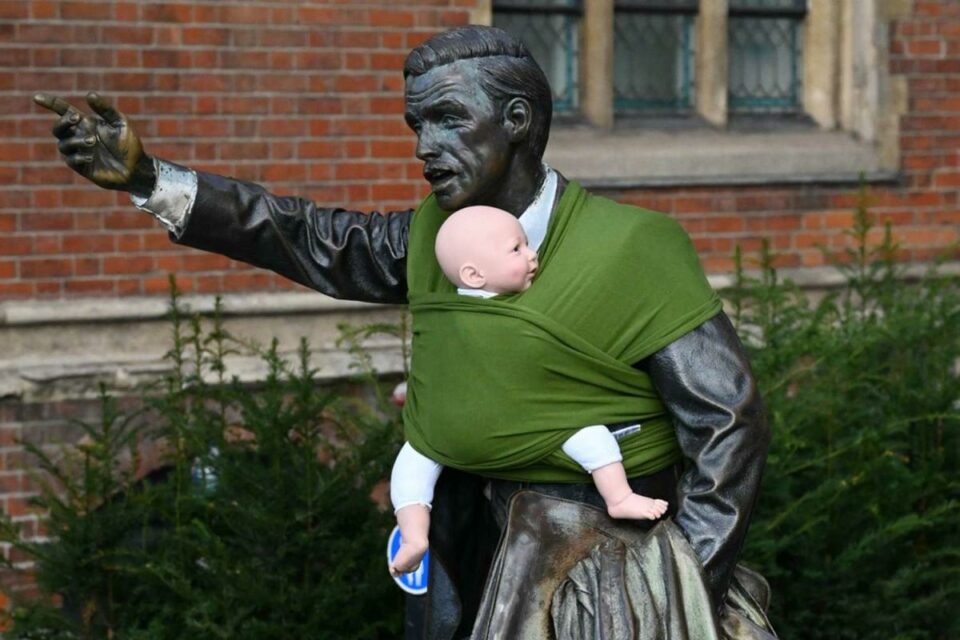What does the appearance of fake baby slings on statues of men in the United Kingdom invite individuals to engage with?
Meta Title: The Mystery of Fake Baby Slings on Statues of Men in the United Kingdom
Meta Description: Discover the bizarre trend of fake baby slings appearing on statues of men in the United Kingdom and why it’s capturing the attention of the public.
Introduction
In the United Kingdom, a mysterious and unusual trend has been emerging – fake baby slings appearing on statues of men. This curious phenomenon has sparked intrigue and speculation, leaving many people wondering about the reasons behind it. In this article, we will delve into the details of this peculiar occurrence, exploring the possible motivations and implications. Let’s unravel the mystery of why fake baby slings are suddenly appearing on statues of men in the United Kingdom.
Uncovering the Trend
In recent months, statues of notable male figures in the United Kingdom have been adorned with fake baby slings. From famous historical figures to contemporary icons, these statues have been transformed into depictions of men carrying babies in slings. The trend has gained attention through social media and news outlets, with many members of the public expressing amusement and curiosity about the phenomenon.
Possible Motivations
While the appearance of fake baby slings on statues of men may seem whimsical and lighthearted, there are underlying motivations that drive this trend. Some speculate that it is a form of social commentary, challenging traditional gender roles and expectations. Others view it as a creative and playful way to provoke thought and spark conversations about parenthood and caregiving. Additionally, the trend may serve as a form of artistic expression, capturing the public’s imagination through unexpected and visually striking displays.
Implications and Reactions
The presence of fake baby slings on statues of men has prompted varied reactions from the public. Some people embrace it as a clever and thought-provoking form of public art, bringing a touch of humor and warmth to the urban landscape. Others question the appropriateness of altering historical and cultural symbols in this manner, raising concerns about vandalism and preservation of public monuments. As the trend continues to unfold, it invites discussions about the intersection of art, social commentary, and public space.
Case Studies
Several prominent examples illustrate the widespread nature of this trend. In Manchester, a statue of Friedrich Engels has been adorned with a fake baby sling, sparking conversations about his legacy and the symbolism of caregiving. Similarly, the statue of Sir Nigel Gresley in King’s Cross has been transformed into a depiction of a man carrying a baby in a sling, adding a whimsical touch to the surrounding area. These instances serve as compelling case studies of the impact and resonance of the trend.
Practical Tips
For individuals interested in witnessing the phenomenon firsthand, it is advisable to stay informed about the latest developments through social media and local news sources. As the trend continues to unfold, new instances of fake baby slings appearing on statues of men may surface in different locations. Keeping an open mind and engaging in conversations about the trend can offer insights into the motivations and interpretations behind these creative displays.
Firsthand Experience
Those who encounter statues adorned with fake baby slings can partake in the experience by documenting and sharing their observations on social media. By contributing to the ongoing dialogue surrounding the trend, individuals can offer their unique perspectives and interpretations, enriching the collective understanding of this intriguing phenomenon. Whether through photographs, commentary, or artistic responses, firsthand experiences can contribute to the vibrant tapestry of public discourse.
Conclusion
The appearance of fake baby slings on statues of men in the United Kingdom has captured the imagination of the public, inspiring contemplation and dialogue. Whether viewed as a form of social commentary, creative expression, or playful artistry, this trend offers a unique lens through which to explore themes of parenthood, gender roles, and public space. As the phenomenon continues to unfold, it invites individuals to engage with the unexpected and embrace the enriching complexity of public art and cultural expression.
A Unique Initiative in the U.K. Advocating for Better Paternity Leave
In the United Kingdom, a grassroots movement known as the Dad Shift is taking innovative steps to push for improved paternity leave options. Their approach involves tying life-size baby dolls to statues using slings as a symbolic demonstration of their cause.
These activists have chosen prominent figures from London and Edinburgh, such as Gene Kelly, Thierry Henry, Isambard Kingdom Brunel, Robert Fergusson, Ken Buchanan, and Wojtek the Soldier Bear to affix these baby doll symbols to. Their goal is to urge government officials for an expansion of parental leave requirements.
The Dad Shift advocates are dedicated to highlighting the significant role that fatherhood plays in men’s lives and emphasize why it is essential for the UK government to provide better paternity leave options for fathers and co-parents. They have announced plans to present an open letter directly to Prime Minister Keir Starmer this month.
Their open letter addresses several points on how improved paternity leave would benefit not only families but also society as a whole by boosting economic growth while prioritizing family support. Furthermore, they provide data showing that countries with longer paternity leave periods also have smaller gender pay gaps and workforce participation gaps.
Currently in the U.K., new fathers are only entitled to up to two weeks of parental leave at £184.03 (or $242.11) per week, which is considered one of Europe’s worst statutory paternity offers. Additionally, statistics reveal that one-third of fathers take no parental leave at all when a new child arrives due to financial struggles associated with taking time off work.
In their plea directed towards Prime Minister Keir Starmer, the Dad Shift references his prior commitment shown during election times when criticized for prioritizing family time over public engagements - asking him now “to show up” just like he did during his campaign by supporting their call for affordable and substantial parental leave.
The Dad Shift urges Starmer not just considering extended affordable parental leaves but advocating equality among parents while encouraging dads across the country sufficient time they need with their children. This innovative advocacy emphasizes that providing better paternal support will ultimately benefit everyone involved – mothers included.
This unique approach taken by The Dad Shift signifies an expanding conversation about paternal challenges regarding work-life balance and sets precedence on including men’s roles in advocating for family rights across society.
For more updates on current trending topics make sure you are signed up our newsletter!



Why Fake Babies in Slings Are Suddenly Appearing on Statues of Men in the United Kingdom